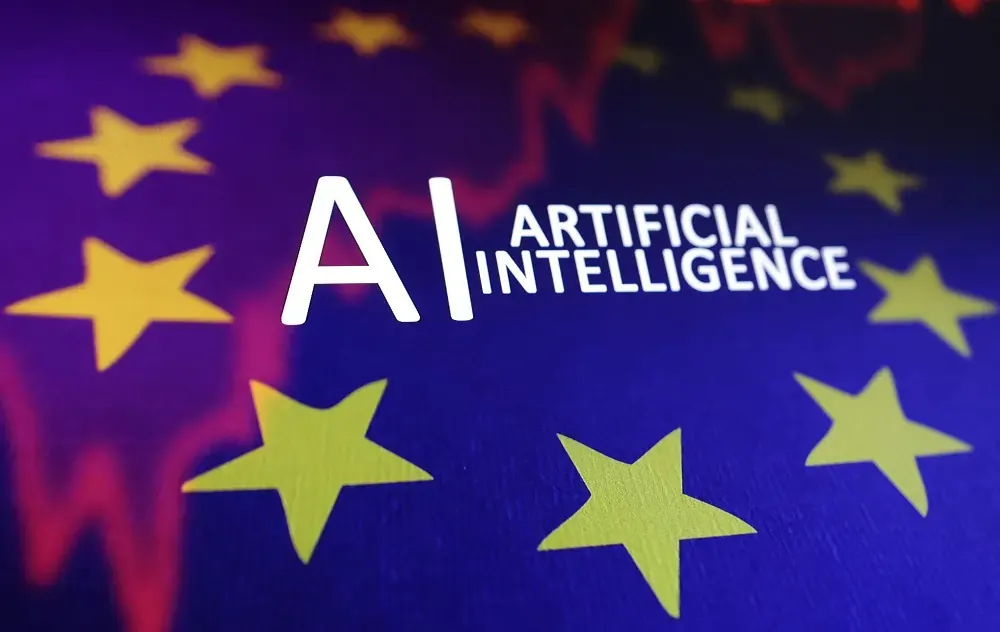
LONDON (Reuters) – European stock pickers are turning to more established sectors like utilities, professional data providers and even copper miners to tap into the next wave of the AI boom, a year after AI chipmaker Nvidia’s emergence as a driving force.
Enthusiasm for artificial intelligence helped drive a rally across equity markets in 2023, propelling Nvidia and Dutch semiconductor equipment supplier ASML into the spotlight.
Nvidia shares are hovering close to record highs ahead of its quarterly earnings due late on Wednesday. However, some of the sheen has rubbed off Europe’s AI-linked megacaps, prompting investors to seek out cheaper alternatives.
Stock pickers are now looking at companies and sectors that are likely to be long-term AI beneficiaries.
“The first phase of AI was obviously chipmakers like Nvidia. Then you’ve already seen the second wave move to the industrial companies which actually supply the components to the data centres,” said Bernie Ahkong, CIO Global Multi-Strategy Alpha at UBS O’Connor.
“And now we’re just starting to get the third phase into utility/power firms in the past several weeks.”
FIRING UP THE DATA CENTRES
Data centres, which are essential to the rise of generative AI, need huge amounts of energy and this is expected to surge as demand for the centres accelerates.
The International Energy Agency estimates total power consumption from data centres will top 1,000 terawatt hours (TWh) by 2026 – roughly what Japan consumes now – from 460 TWh in 2022.
“One of the most interesting ways within Europe to play AI on a multi-year basis actually is via some of these utilities companies,” UBS O’Connor’s Ahkong said.
Demand for data centre space in Europe is also set to outstrip delivery of new stock for the third straight year and AI demand will exacerbate the issue, said Kevin Restivo, who heads European data centre research at real estate services provider CBRE.
In the last five weeks, the utilities index has risen over 9%, driven largely by expectations for interest rate cuts, versus a 4.7% rise in the main STOXX 600 index. But they are still lagging the rest of the market year-to-date, up just 0.2% versus a 9% rise in the benchmark index.
Bank of America said in a recent note European utilities bosses are talking about AI, but upside potential from data centres is “anecdotal at best”.
Even so, the bank says plenty of companies could benefit from a boom in AI-linked power demand, from Fortum, Verbund and renewables supplier EDP, to larger players like RWE, Iberdrola, Enel and Engie.
ADOPTERS VERSUS ENABLERS
A year ago, investors had been jittery around the disruptive potential of AI for anything from IT services to media, education and consulting.
“How I look at AI in the UK, the US has the enablers, we’ve got the adopters,” Trevor Green, head of UK equities for Aviva Investors, said.
“When investors will get particularly interested is when we can actually quantify this in revenue potential. The providers are rightly still being a bit evasive on this as we are at such an early stage of adoption,” he said.
He highlighted the London Stock Exchange, information and analytics group RELX and software group Sage as examples of companies that have been working on AI for years.
“Now we are properly starting to see revenue-generating opportunities from it,” he said.
Marcel Stotzel, co-portfolio manager of Fidelity European Fund and Fidelity European Trust, says a lot of the AI hype has been around the big U.S. names behind the technology.
In the past year, shares in the likes of OpenAI backer Microsoft and Alphabet’s Google have shot up 33%-41%.
Meanwhile, some European companies have been quietly using AI to develop new products that are already benefiting their customers, said Stotzel.
“This has resulted in the European-listed beneficiaries trading at more attractive valuations,” he said, listing German software company SAP and Swiss drugmaker Roche among those his team are focused on to play the AI theme.
Miners are another area of investor interest, particularly for copper, which has hit record highs above $11,000 a metric ton this week, spurred largely by a shortage of material for prompt delivery.
Commodity trader Trafigura believes copper demand linked to data centres and AI could add up to one million tons by 2030 and exacerbate supply deficits towards the end of the decade.
“The copper boom is also part of the AI craze,” Kathleen Brooks, research director at trading platform XTB, said.
(Reporting by Lucy Raitano; Editing by Amanda Cooper and Emelia Sithole-Matarise)


